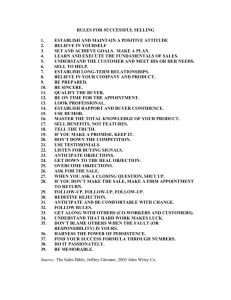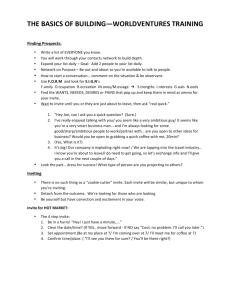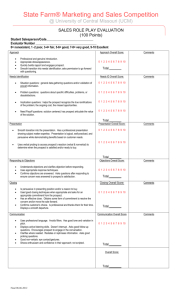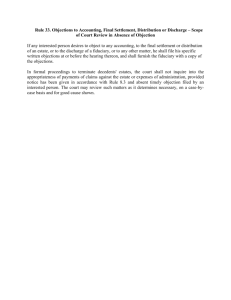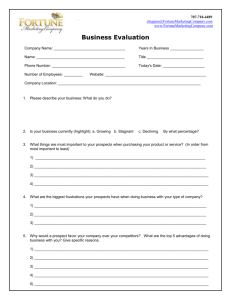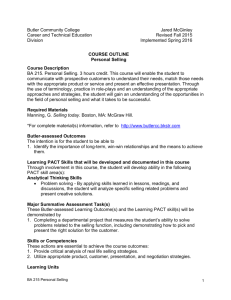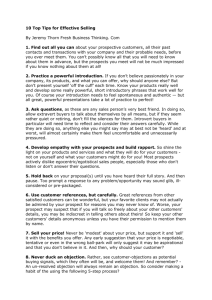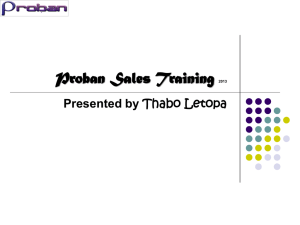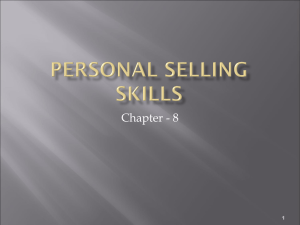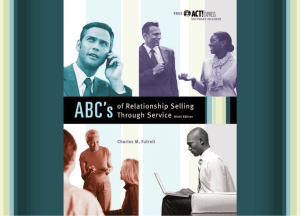Successful selling skills: seven keys to selling your
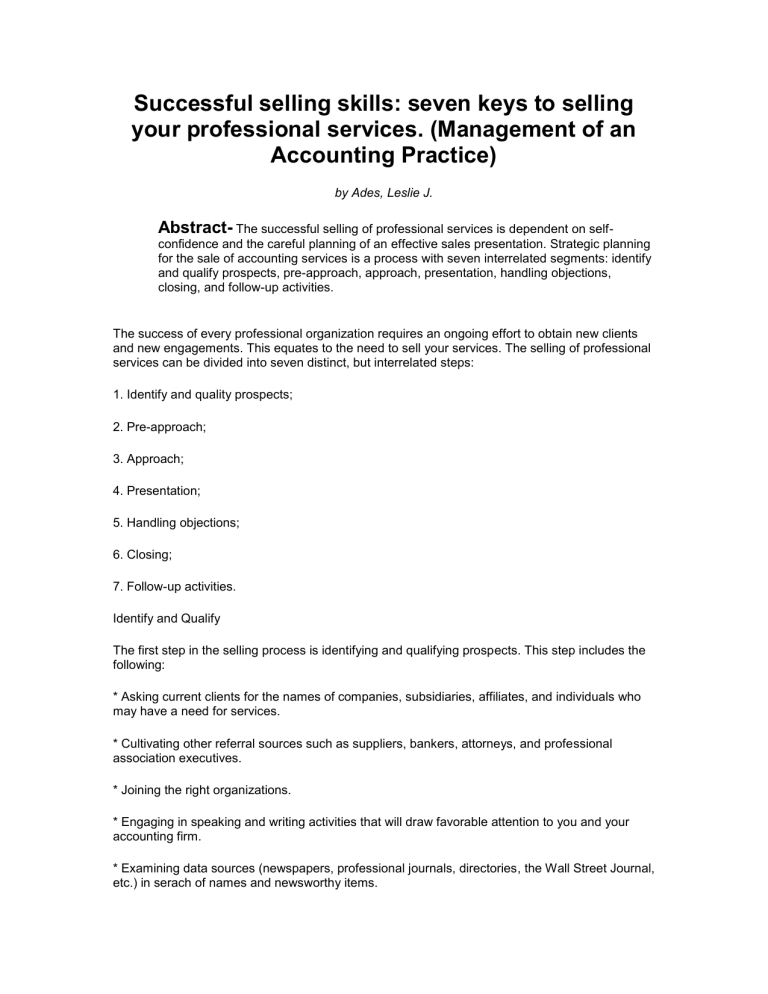
Successful selling skills: seven keys to selling your professional services. (Management of an
Accounting Practice)
by Ades, Leslie J.
Abstract-
The successful selling of professional services is dependent on selfconfidence and the careful planning of an effective sales presentation. Strategic planning for the sale of accounting services is a process with seven interrelated segments: identify and qualify prospects, pre-approach, approach, presentation, handling objections, closing, and follow-up activities.
The success of every professional organization requires an ongoing effort to obtain new clients and new engagements. This equates to the need to sell your services. The selling of professional services can be divided into seven distinct, but interrelated steps:
1. Identify and quality prospects;
2. Pre-approach;
3. Approach;
4. Presentation;
5. Handling objections;
6. Closing;
7. Follow-up activities.
Identify and Qualify
The first step in the selling process is identifying and qualifying prospects. This step includes the following:
* Asking current clients for the names of companies, subsidiaries, affiliates, and individuals who may have a need for services.
* Cultivating other referral sources such as suppliers, bankers, attorneys, and professional association executives.
* Joining the right organizations.
* Engaging in speaking and writing activities that will draw favorable attention to you and your accounting firm.
* Examining data sources (newspapers, professional journals, directories, the Wall Street Journal, etc.) in serach of names and newsworthy items.
Pre-Approach
The second step is the pre-approach. The pre-approach is that strategic selling activity which enables you to learn as much as possible about the organization you have identified. You must ascertain what this company needs, who is involved in the buying decision, and what are their personal characteristics, buying styles, and organizational relationships. These activities encompass:
* Setting objectives to make contact.
* Determining the best method of approach. Should it be by a personal visit, telephone call, letter, third-party introduction, etc.?
* Developing an overall approach strategy. Who will you contact first, and why?
* Preparing an effective opening statement.
* Developing fact-finding questions.
* Preparing your sales message.
* Ascertaining the best timing to make contact.
An important part of the pre-approach is to understand the thinking of an organization which leads it to a purchase decision. For example, why does one company engage only large-sized accounting firms?
Approach
The third step is the approach. The sales process begins with the approach, or first direct meeting with a new prospect. First impressions do matter, and personal appearance, poise, opening lines, and follow-up remarks will be a factor. The next step is to further qualify the prospect: to identify needs and your ability to serve them. Some of the following questions will help determine why an accounting service is either being sought, or a change is being considered.
* "What does your present CPA do for you?"
* "Do you meet with him/her periodically to discuss tax savings opportunities?"
* "Do you have conversations about your key-executive retirement program?" These, and other opening questions and probes should help to obtain appropriate information which will then enable you to focus attention on your prospect's problems and needs. Careful listening and the use of a checklist are important at this stage. Part of the qualifying activity should be to understand who has the authority to engage the CPA firm; are you speaking to the right person?
Do not make the fatal mistake of beginning the sales presentation until after all relevant areas of concern have been identified, and a confirmed agreement of an acceptable solution has been reached. Ask these questions:
* "What are the factors that are important to you in making your decision?"
* "What requirements are you now seeking to satisfy with a professional service like this?"
* "What kind of savings do you expect?"
* "Why is it important to you?" Wait for answers to the questions. Only after you have established their needs can you proceed with your sales presentation. Sometimes it is more prudent to terminate the meeting at this juncture so that you can return with a more focused in- depth sales presentation.
Summarize with your prospective client the major points that have emerged from your conversation thus far. Summarizing, along with repetition and reinforcement are important principles which enhance buyer understanding. There is a lot of repetition in selling because the interaction is verbal. The reasons for summarizing at this stage of the interview are threefold:
* To confirm understanding;
* To re-identify the main points to be discussed;
* To make sure that nothing has been omitted.
Thus it can be seen that a truly professional "business-getter" is not only an excellent communicator and listener, but a teacher as well. If the prospective client does not understand the want-satisfying capabilities of your professional services as they relate to his or her operational success, then there will be scant value perceived in engaging your firm. Need, use, and value must always be established in the prospect's mind before fee can enter the discussion.
* You summarize the information in the order in which you requested it, and ask, "Is there any other point we have not talked about that you feel is worth mentioning before we go any further?"
* You conclude your information gathering process by making the following statement of intent:
"There seems to me to be no apparent reason why you should continue under your present conditions. I believe that I can offer you an alternative which will not only solve your present problems, but give you a much better final result at only slightly more than your current cost."
This provocative statement serves as the bridge to your sales presentation.
Presentation
The fourth step in the strategic selling process is the sales presentation, or the telling and selling phase. The sales presentation sequence includes all of those activities involved in presenting yourself and your accounting firm as professional problem solvers, rather than product pushers.
This requires excellent oral communication and negotiation skills. Based upon the previous input received from your prospect, you now present yourself and your firm's professional service capabilities as the logical solution to their business problems.
Sales presentation guidelines. Try to solve these problems by linking your professional services features to client benefits. You are selling benefits and timely solutions to previously identified business problems. Your earlier questioning technique helped you to identify what is needed, or desired, as opposed to what has been delivered. If you can make your prospective client aware of this gap, dissatisfaction will become evident along with a desire to overcome it. In other words, you must give them a "headache" before you present them with an "aspirin"!
You must also show competitive distinctiveness, prepare for any objections, and involve your prospect in the discussion. Give the most desirable information first, while using two-sided
arguments--present the most favorable information before the less favorable. Try to draw conclusions whenever possible so that you are always summarizing for agreement--and possible commitment. Make the buying decision easy by creating a positive and accepting atmosphere.
The parallel technique of selling. Remember, that in deciding to engage a firm, the prospect wants to satisfy both personal and operational requirements. The personal, or primary, requirements are inherent factors that influence personal and individual actions. The operational, or secondary, requirements are the business needs for a service which solves a specific problem.
The parallel technique of selling takes into consideration this dichotomy of buyer needs and purchasing objectives. That is why it is mandatory to discover the factors that motivate an individual before you launch into a full-blown presentation or proposal.
People buy the expectation of benefits, not the generic services themselves. To the client, these benefits are the service. When purchasing an intangible like accounting services, there is a lot of buyer uncertainty, because the buyers do not really know what they are getting or whether they have in fact received what they are paying for.
The sales presentation is the heart of the selling process. There are a diverse number of approaches to the selling interview. The approach you select will be determined by your attitude, your relationship with the prospect, their maturity, expertise and experience level, and your own objectives. whichever method, or combination of approaches that you use, you will always make a grand summary prior to attempting to close the sale. This summary will enable you to ascertain whether or not you have covered all of the ground necessary to consummate negotiations. At this point, you will either get the engagement or an objection.
Handling Objections
Handling objections is the fifth step in the strategic selling process. Overcoming objections is mandatory for success in selling. Objections are to be expected; do not become alarmed or discouraged if your prospects and clients object before, during, or after your sales presentation.
Objections are statements, comments, requests for information, or inaccurate statements by the prospect which need clarification. It is a dramatic form of miscommunication between buyer and seller. Because there is a big difference between an excuse and an objection, the recommended procedure for handling objections is as follows:
* Listen carefully before answering.
* Act interested in the objection. Do not attempt to belittle it, or magnify it.
* Restate the objection before answering it. Make sure that you fully understand it. If not, get clarification.
* Isolate the objection while trying to determine the real, or hidden, objection.
* Convert the objection into the form of a question.
* Answer the objection and then ask your prospect: "Does that satisfy your concern?" Or, "Does that answer your question?"
* Ask for the engagement, or get back to your presentation.
Remember, a prospect's "no" might be definite for now, but it will surely not remain so forever.
Also, when they object, prospects are objecting to your proposal; not to you. Therefore you should not take it personally--rejection is an integral part of selling.
Closing
The sixth step in the professional selling process is closing the sale, or consummating negotiations. Closing the sale means resolving doubts, reassuring your prospect, and obtaining the engagement decision.
Gaining client commitment should be the ultimate goal of all of your selling efforts. Closing is not the art of getting a decision, but the art of making a decision that your prospects will approve.
After all, you are the expert in your field, and why shouldn't you assert your knowledge? Your effectiveness as a "closer" is directly determined by your attitude toward your client, yourself, your firm, and to the selling process itself. You must view it as a legitimate and necessary function.
Furthermore, you should expect to get the engagement--every time! Thus, it can be seen that selling is merely a state of mind. If you believe that you can do it, you will. If you think you can't, you won't!
Follow-Up Activities
The seventh, and final, step in the strategic selling process is the after the sale follow through.
This is probably the most crucial of all of the action phases of selling, as you are involved with your new client's post-purchase behavior. Their purchasing behavior started with the recognition of a personal or business problem and then proceeded to an information search and the evaluation of alternatives. Your firm and its array of professional services were one of several alternatives. They selected you and your firm, and now that they have made an engagement decision, it is natural for their management to have second thoughts or doubts. In selling terminology this is called "Buyer's Remorse."
When buying an intangible, such as accounting services, a prospect never knows for certain what it is buying and still is not sure afterwards. You must constantly reinforce the buying decision.
Since you are selling the "promise of a benefit" which cannot be tasted, sampled, or touched, there is a great deal of uncertainty throughout your presentation; but particularly after the buying decision has been made. It is most important that you reassure the new client and positively reinforce their buying decision during the closing and follow-up stage. Therefore, you must pay particular attention to their needs and continue partner contact during the early stages of your new professional relationship. By initiating periodic client "check-up" meetings you are validating your original commitment to them, and minimizing the possibility of losing them to a competitor.
Conclusion
There is no substitute for professional salesmanship. Never make the mistake of thinking that brochures, proposals, third-party testimonials, or your firm's reputation will make the sales for you. No piece of paper or advertisement can ever do the selling job as well as a carefully planned and executed sales presentation. If you believe in yourself and follow the seven strategic steps involved in the professional selling process, you will be able to increase your client base.
